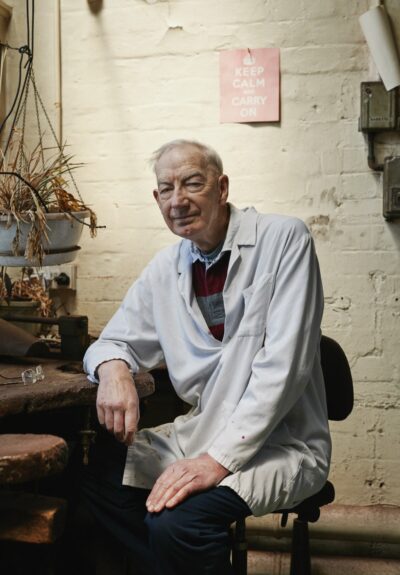Portrait by Andy Pilsbury
Ray grew up in Solihull, and as a child remembers experiencing air raids during World War II. Now aged 84, he has been involved in the Jewellery Quarter for 68 years and has seen an enormous amount of change during that time.
His first job in the silver trade was at Barker Brothers, a large silversmithing company, as a junior chaser. Ray stayed here for two years before moving on and spending some time working as a stores assistant for the British Army in Egypt. Ray returned to Barker Brothers in 1956 and this time he stayed at the company for fourteen years. During his time at Barker Brothers, Ray developed his skills as a hand chaser. Hand chasing is a metalworking technique in which a malleable metal is shaped by hammering on the front side, sinking the metal. Ray uses a technique called pitch backing, where pitch is heated until it is soft enough to make contact with the metal and then allowed to cool in order to hold the metal in place.
Ray set up on his own in around 1970 and eventually moved into the workshop on Frederick Street where he is still based, sharing a space with silversmiths Anna Lorenz, Kevin Grey, James Butler and Andrew Macgowan.. He is one of very few hand chasers remaining in the Quarter, perhaps the only one left.
– Ray HassallI get it empty, its polished but that’s all and then I would fill it with pitch and after that when the pitch has gone cold, you leave it overnight usually and then it’s alright for in the morning, and then you mark it out and chase it. Then you have to empty it, in the old days we had ovens which were ideal…now I have to blast it out with a blow pipe and it can get a bit awkward.
Listen to Ray
Ray talks about the process of chasing and how it's changed over time




